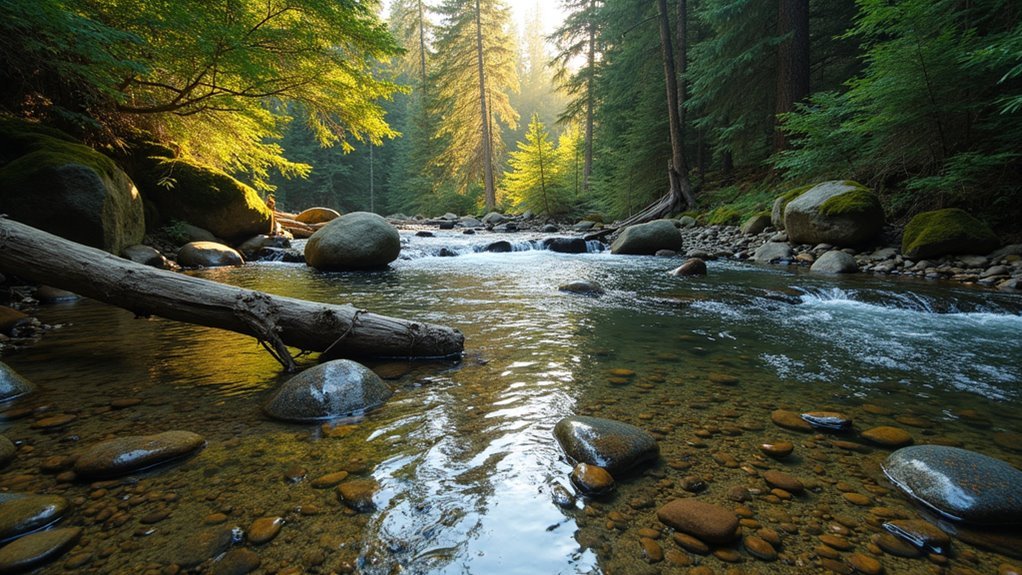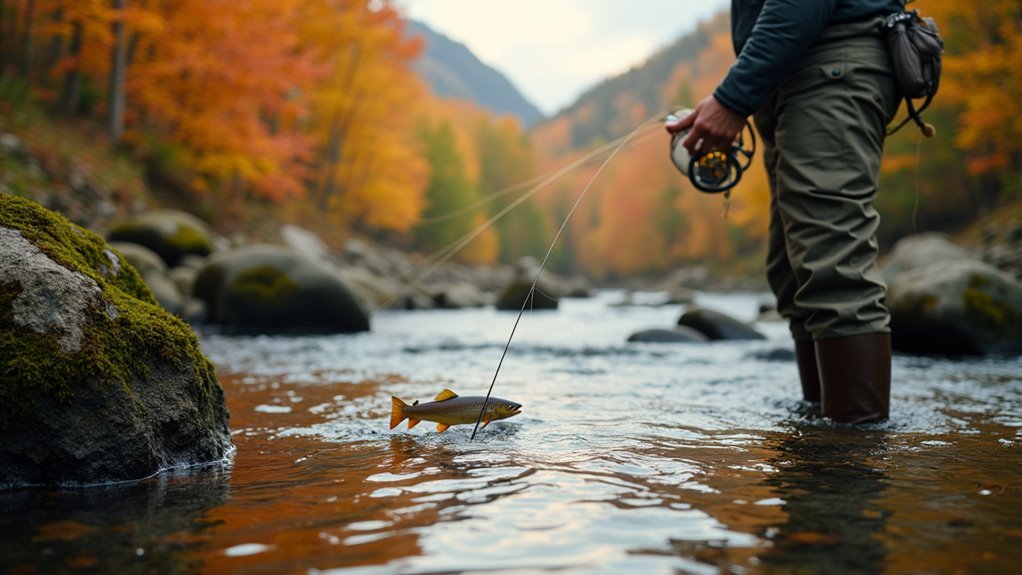Successful brook trout fishing requires understanding their habitat preferences and seasonal behaviors. These cold-water natives thrive in oxygen-rich environments with protective cover like fallen trees and undercut banks. Anglers should adjust tactics seasonally—targeting shallow areas in spring, deep pools during summer, and gravelly spawning grounds in fall. Light tackle (4-6 pound test) and stealthy upstream approaches prevent spooking these skittish fish. Mastering still water strategies and downsizing gear in pressured waters will greatly improve your brookies success rate.
The Prime Habitats for Brook Trout Success

Finding the perfect brook trout habitat is perhaps the most essential element of a successful fishing expedition.
These fish thrive in cold, clean water between 45 and 65 degrees, typically found in higher elevation streams, ponds, and lakes throughout Eastern North America.
Brook trout require pristine, cool waters at higher elevations across the Eastern seaboard to flourish.
The most productive spots often combine oxygen-rich water with protective cover. Look for fallen trees, deep pools beneath riffles, and undercut banks where trout can hide from predators while ambushing food.
Rocky bottoms in streams and shallow, gravelly areas in ponds become especially important during fall spawning season.
Remember that brook trout behavior shifts seasonally, so your habitat focus should adjust accordingly.
Seasonal Patterns: When and Where to Find Brook Trout
Although brook trout can be caught year-round, understanding their seasonal patterns dramatically increases an angler’s chance of success.
These beautiful fish adapt their behavior to changing temperatures and spawning cycles, which means anglers should adjust their approach accordingly.
- Spring – Target shallow areas that warm first as ice melts; fish feed actively after winter
- Summer – Focus on deep, cold holes and shaded sections; fish early mornings or evenings
- Fall – Prime season during spawning; look for gravel bottoms in streams or shallow rocky areas in ponds
- Winter – Ice fishing in shallow structures in the morning, moving deeper in afternoon
Essential Gear and Setup for Targeting Brook Trout
Success in brook trout fishing relies heavily on selecting the right gear for the specific conditions and techniques being employed.
Light to ultra-light rods in the 4-6 foot range are ideal for small streams, while medium-light setups work better for larger waters. I think a 4-6 pound test line strikes the perfect balance between sensitivity and strength.
For flies, it’s worth carrying a mix of patterns – perhaps some dry flies for surface action and nymphs for deeper presentations.
When spin fishing, small spoons and spinners in silver or bright colors tend to produce well, especially in slightly murky conditions.
Polarized sunglasses are absolutely essential, not just recommended.
Stream Fishing Tactics That Land More Brookies

Many successful brook trout anglers approach stream fishing with a stealthy, upstream movement that prevents alerting these notoriously skittish fish.
Their shadows falling downstream rather than over potential holding spots makes all the difference when targeting these colorful predators.
Careful positioning ensures your shadow doesn’t betray your presence when pursuing these vibrant, cautious gamefish.
I think what separates casual fishers from those who consistently catch brook trout is attention to detail and perhaps a bit of patience.
Water temperature plays a vital role in determining where brookies might be holding.
- Cast to undercut banks and fallen trees where trout hide from predators
- Use light tippet (4-6x) to avoid spooking wary fish
- Match flies to current insect hatches, especially during morning/evening periods
- Wade carefully, as vibrations through stream beds alert trout to danger
Still Water Strategies for Bigger Brook Trout
When targeting brook trout in lakes and ponds, experienced anglers often discover that the techniques differ considerably from stream fishing approaches.
Still waters demand a more methodical strategy, particularly when hunting trophy brookies.
Spoons and blade lures shine in these environments, with silver or nickel varieties excelling in clear water.
During warmer months, focus on deeper, cooler sections near drop-offs where oxygen levels remain adequate.
Perhaps the most productive time is fall, when brookies move to shallow rocky areas for spawning.
Morning hours typically yield better results, especially during summer.
I think combining artificial lures with live bait often proves most effective for those particularly finicky still-water trout.
Advanced Techniques for Pressured Waters
Brook trout inhabiting heavily fished waters require anglers to elevate their approach beyond basic techniques, as these fish quickly become educated to standard presentations.
In these challenging conditions, success often depends on subtlety and patience rather than aggressive approaches that might work in more remote waters.
- Downsize terminal tackle – use 6-7X tippet and smaller flies/lures than you think necessary
- Present from downstream when possible to remain outside the trout’s cone of vision
- Focus on dawn/dusk periods when pressure is typically lower
- Target overlooked water that most anglers walk past
Frequently Asked Questions
How Do Brook Trout Respond to Barometric Pressure Changes?
Like sensitive barometers, brook trout respond distinctly to pressure changes. They typically become more active during stable or slightly falling pressure and less active when barometric pressure rises rapidly.
Can Brook Trout Be Caught Effectively at Night?
Brook trout are mostly daytime feeders with limited night activity. While possible to catch after dark, effectiveness considerably decreases compared to dawn or dusk fishing opportunities when they’re more active.
Do Brook Trout Prefer Live Bait Over Artificials During Winter?
Brook trout generally prefer live bait over artificials during winter. Their slower metabolism makes them less likely to chase lures, responding better to natural baits presented directly in their feeding zones.
How Long Should You Fish a Spot Before Moving On?
A fisherman might wait FOREVER at one spot—but realistically, most anglers should give each location 15-30 minutes before moving on if there’s no action, especially when pursuing brook trout.
Do Brook Trout Return to the Same Spawning Grounds Yearly?
Brook trout typically return to the same spawning grounds each fall, showing strong site fidelity. This predictable behavior helps anglers target productive locations during the spawning season.